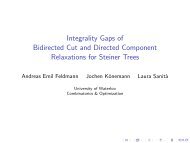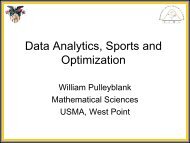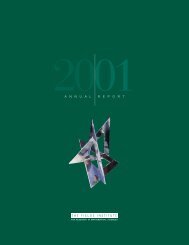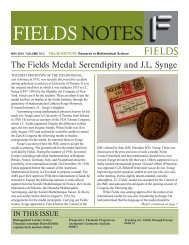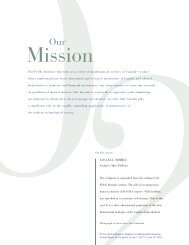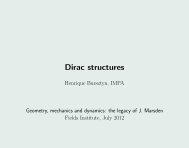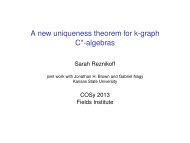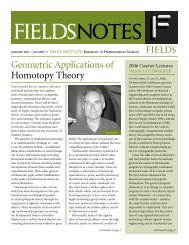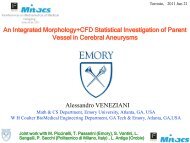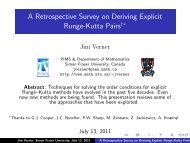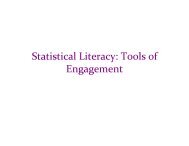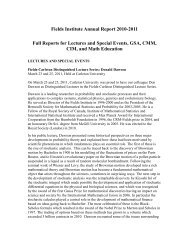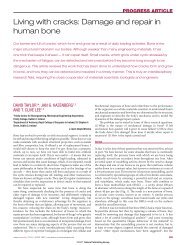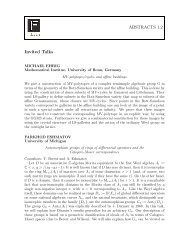Annual Report 2005 - Fields Institute - University of Toronto
Annual Report 2005 - Fields Institute - University of Toronto
Annual Report 2005 - Fields Institute - University of Toronto
Create successful ePaper yourself
Turn your PDF publications into a flip-book with our unique Google optimized e-Paper software.
Achim Kempf <strong>of</strong> the <strong>University</strong> <strong>of</strong> Waterloo gave the second<br />
talk, “Discreteness vs. Continuity: From Music Recordings<br />
to Cosmology” which discussed the significance <strong>of</strong> being<br />
able to interchange between discrete structures and continuous<br />
structures. The talk took an exciting tour through<br />
the history <strong>of</strong> the discrete versus the continuous – how a<br />
link between the two structures aided in the progression <strong>of</strong><br />
music recordings, the development <strong>of</strong> sampling theory, and<br />
the partial solutions to unsolved questions remaining in the<br />
field <strong>of</strong> mathematical physics focusing on cosmology.<br />
The students present learned <strong>of</strong> the many options available<br />
to them through the large variety <strong>of</strong> graduate programs at<br />
Canadian universities, which provide a solid foundation to<br />
future mathematicians.<br />
New Fellows <strong>of</strong> the Royal Society <strong>of</strong> Canada<br />
October 24, 2004<br />
Held at the <strong>Fields</strong> <strong>Institute</strong><br />
In the Fall the <strong>Fields</strong> <strong>Institute</strong> celebrated the election <strong>of</strong> new<br />
members to the Academy <strong>of</strong> Sciences <strong>of</strong> the Royal Society <strong>of</strong><br />
Canada with an afternoon <strong>of</strong> lectures by a selection <strong>of</strong> the<br />
initiates.<br />
Elizabeth Cannon, Stephen Fienberg,<br />
Jacques Hurtubise and Barbara Sherwood Lollar<br />
L e c t u r e s a n d S p e c i a l E v e n t s<br />
Both inductees from the mathematical sciences gave presentations,<br />
as did two others working in related disciplines.<br />
This year’s talks gave a fascinating overview <strong>of</strong> several<br />
fields, and also promise to stimulate some new interdisciplinary<br />
contacts.<br />
Elizabeth Cannon<br />
Positioning and navigation with the global positioning system:<br />
pushing the limits<br />
Elizabeth Cannon is Pr<strong>of</strong>essor <strong>of</strong> Geomatics Engineering<br />
at the <strong>University</strong> <strong>of</strong> Calgary. This is the scientific discipline<br />
that brings us the GPS (Global Positioning System). Her<br />
talk had three parts: the history <strong>of</strong> the development <strong>of</strong><br />
GPS technology (driven originally by military needs, but<br />
now primarily by societal and commercial applications); a<br />
description <strong>of</strong> how GPS systems work (simple mathematics<br />
enters, like the geometry <strong>of</strong> triangulation, and also more<br />
advanced mathematics, needed to analyze the reflection <strong>of</strong><br />
signals); and finally, a preview <strong>of</strong> developments yet to come:<br />
integration <strong>of</strong> GPS with “dead reckoning”; applications to<br />
ship clearance, to 911 services, to automation <strong>of</strong> operations<br />
like variable rate fertilizing, and animal tracking and search<br />
and rescue.Stephen Fienberg<br />
Stephen Fienberg<br />
Mathematical glimpses <strong>of</strong> statistical models for frequency data<br />
at work<br />
Stephen Fienberg, who is the Maurice Falk <strong>University</strong> Pr<strong>of</strong>essor<br />
<strong>of</strong> Statistics and Social Science at Carnegie-Mellon<br />
<strong>University</strong>, is from <strong>Toronto</strong> and spent part <strong>of</strong> his career at<br />
York <strong>University</strong>. He has been president <strong>of</strong> the <strong>Institute</strong> <strong>of</strong><br />
Mathematical Statistics. In his talk, mathematical glimpses<br />
<strong>of</strong> statistical models for frequency data at work, he spoke<br />
about contingency tables for high dimensional data and<br />
their relation to algebraic geometry. By redefining the<br />
parameters <strong>of</strong> a log-linear model in terms <strong>of</strong> various odds<br />
ratios, one can then restrict these odds ratios in interesting<br />
ways, leading to more robust and parsimonious models. It<br />
is perhaps worth mentioning that, in addition to the elegant<br />
mathematics presented in his talk, Fienberg is well known<br />
for is work in very applied areas, and has contributed to the<br />
dialogue on the use <strong>of</strong> US census data.<br />
Jacques Hurtubise<br />
Integrable systems<br />
Jacques Hurtubise is the former Director <strong>of</strong> the Centre de<br />
recherche mathématiques and the newly appointed Acting<br />
Vice-Principal (Research) <strong>of</strong> McGill. Jacques, who was<br />
a student <strong>of</strong> Nigel Hitchin, has worked in several areas,<br />
<strong>Fields</strong> <strong>Institute</strong> <strong>2005</strong> ANNUAL REPORT 45



